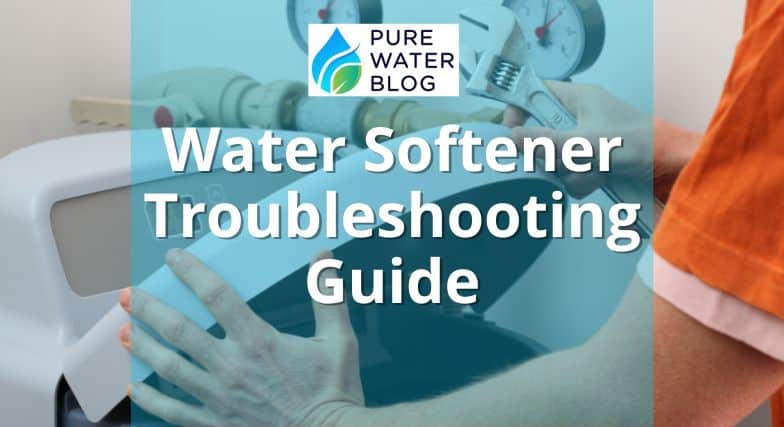Last Updated: December 26, 2023
Is your water softener giving you a hard time? Don’t worry! With this water softener troubleshooting guide, I have got you covered. Let’s dive into 13 easy ways to fix your softening system in no time!
Table of Contents
Quick Answer
Water softener troubleshooting is a breeze when you follow the right guidelines. With my years of experience in the Aqua industry, I have found some easy workaround for the softeners. Let’s have a look at the important highlights:
- If you encounter problems with excess or low water levels in the brine tank, you need to adjust the valve settings accordingly.
- When facing hurdles in initiating the regeneration cycle, focus on potential faulty timers and replace them if necessary.
- If there are any leaks, tighten the loose connections and use a plumber’s tape to fix them.
However, the above list just highlights the basics. Continue reading to learn about 13 different water softener problems and their possible solutions. Moreover, I’ll provide valuable insights on how to prolong the lifespan of your softener, something you definitely won’t want to overlook. Let’s dive deeper into this solutions guide.
Water Softener Problems and Solutions Table At A Glance
Here’s a quick overview of the issues and their fixes. Let’s check them out:
Problem | Solution |
Salt Bridging | Remove crust by draining water, break up with a rod or broom handle, or consider tank drainage. Refill with new salt |
Salt Mushing | Break up mushy salt with a broom or drain tank completely. Refill with new salt |
Water Level Issues | Low: Raise float valve or clean/replace faulty entry valve. High: Adjust the float valve lower |
Proper Salt Utilization | Check/adjust salt dose setting. Perform a backwash cycle to clean tank clogs |
Floating Particles | Flush the system, install extra filters, and use high-purity salt pellets |
Salty Taste in Water | Adjust salt dose setting, seek professional help if needed |
Brown Discoloration | Sterilize the brine tank, install pre-filtration, and replace resin beads |
Regeneration Issues | Repair/replace the timer, clear tube blockages, and ensure proper water pressure |
Unusual Noises | Open the faucet, inspect/tighten screws, and replace broken parts |
Leaks | Tighten connections, check float valve, inspect overflow drain line |
Improper Setup | Check connections, valves, water hardness, salt settings. Factory reset if needed |
Water Pressure Reduction | Ensure the right system size, clear resin clogs, and address iron/sediment accumulation |
Died Water Softener | Examine the power cord, check the outlet and control panel. Seek professional help if issues persist |
Water Softener Troubleshooting: 13 Best Solutions Listed!
Here’s a breakdown of 13 different problems and their possible fixes to make your water soft and flow smoothly. Let’s check them out:
1. Troubleshooting Salt Bridging
A salt bridge forms a hard crust in the brine tank, creating a barrier between the water and the remaining salt below. This hinders the water softener’s ability to dissolve the salt and regenerate the resin beads.
Solution
Fixing a salt bridge is a DIY and quick process. To remove salt bridges from your water softener, follow these steps:
- Before you start, drain 5–10% of the water content to reach the salt. Then, insert a long rod, e.g., a broom handle, into the tank to break the salt bridging.
- Carefully break it by tapping the bridging to dislodge the compacted salt.
- If breaking up the salt bridge proves challenging, consider draining the entire tank.
- After you’re done, add new salt. This makes sure the tank is clean and ready to soften more water.
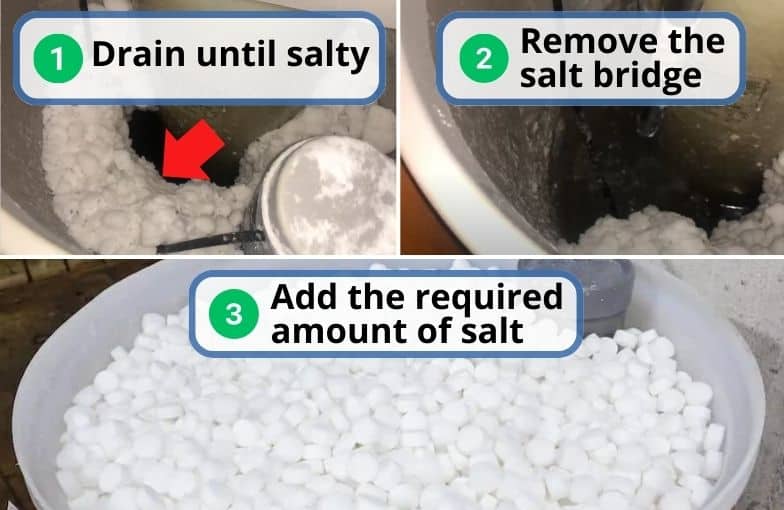
2. Salt Mushing Problems
Salt mushing is often confused with salt bridging. But let me tell you, these two are different problems. This occurs when the salt inside the brine tank compacts and forms a mushy mass.
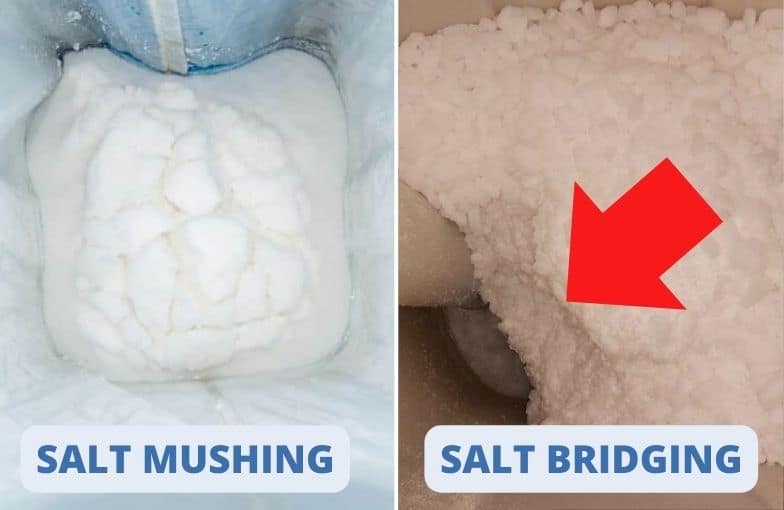
In this case, the brine solution cannot enter the resin tank due to salt mush obstruction, impacting both the regeneration and water softening processes. Moreover, if you ever notice a change in water softness, salt mushing should be one of your first concerns.
Solution:
To remove salt mushing, do the following:
- To turn the mushy salt into its granular state, gently break it up with a broom.
- If the salt isn’t breaking up, drain the tank completely. Remove the remaining salt crystals, then add new salt.
3. Fixing Water Level Issues
Facing water level problems in your softener can disrupt its effectiveness. The following are a couple of easy ways to deal with both low and high water levels. Let’s learn more about them:
Low Water Levels
Before diving into details, you should understand that a float valve is responsible for maintaining the water level.
- If it is set too low, it will prevent the water from entering the tank.
- In this case, raise the float valve to a higher position by turning the knob clockwise.
Moreover, another possible reason could be a faulty entry valve whose function is to let the water enter in softening system. If it is damaged or there is any blockage, the supply water won’t flow through the softener.
High Water Levels
Surprisingly, whether dealing with low or high water levels, the culprit remains the same; that is an improperly adjusted float valve. So, start by checking if the valve is set too high.
You can do this by looking at the water level when the tank is empty. If it’s above three-quarters, gently turn the screw or knob counterclockwise to lower it.
4. Ensuring Proper Salt Utilization
The water softener not using salt as expected can produce ineffective softening, leading to hard water issues. I found that a possible cause could be the improper water softener’s salt dose setting.
Moreover, accumulated debris or sediment in the brine tank can create clogs, preventing the proper dissolution of salt during regeneration. So, let’s check the solution for this.
Solution
Here’s a quick, 2-step process I followed to correct the softener’s configuration:
- First, I checked the salt dose setting, making sure it was on point. The recommended dosage is 3 pounds of salt, which will produce about 1 gallon of brine.
- Then, a good flush by initiating a backwash cycle from the control panel helped me clean the clogs in the tank.

5. Managing Floating Particles
Noticing float particles in your water can be bothersome. This hints at potential issues in your softening system. The problem occurs when the resin beads in the tank are worn out, letting impurities slip through.
Solution
Here’s how to deal with floating particles:
- Initiate a system flush by setting the bypass valve to the bypass position by rotating or sliding it until it aligns with the position marked as “bypass”.
- Then, connect the hose to the drain valve and let the water run for 10–15 minutes until it is clear.
- Opt for high-purity salt pellets like Diamond Crystal and Morton Salt, designed for water softeners.
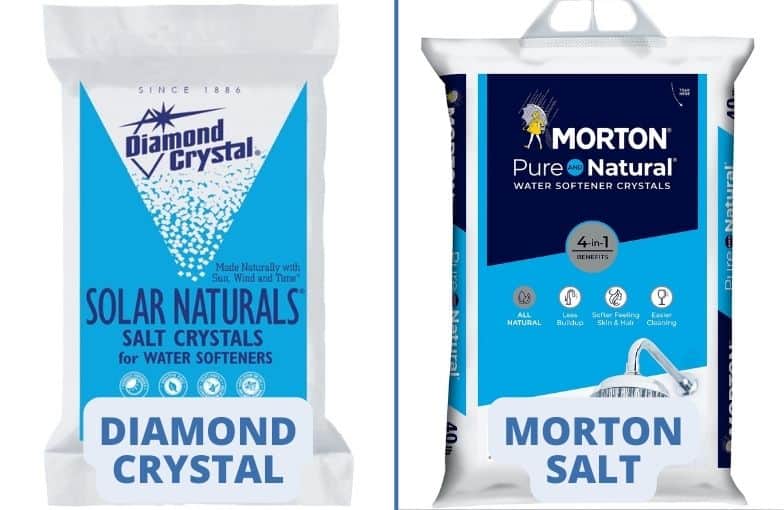

6. Addressing Salty Taste in Water Softener
The perception of a salty taste in your soft water can be undesirable and may indicate potential issues with the water softening system. If there is an excessive buildup of salt residue in the softened water, it can contribute to a salty taste.
Solution
My neighbor, Simon had the same issue. When I discussed the problem with him, he shared that he explored some DIY methods and got rid of salty water. Let me share those steps with you:
- Access the control panel of your water softener and review the salt dose setting.
- Adjust it to the recommended level (3-6 pounds of salt). But I would suggest you get your water hardness tested and adjust the settings accordingly.
7. Investigating Brown Discoloration
When the water becomes brown, it is either due to the presence of bacteria or excessive iron. If you are also having this issue, it can be fixed by following some easy guidelines. Let’s head over to the next section for the solution:
Solution
Listed below is how you can deal with brown discoloration:
- The first thing you need to do is sterilize your brine tank. I would recommend mixing 1 oz of bleach in every 1.5 gallons of water.
- Consider installing pre-filtration systems, such as sediment filters.
- For improved performance of the softener, replace the resin beads.
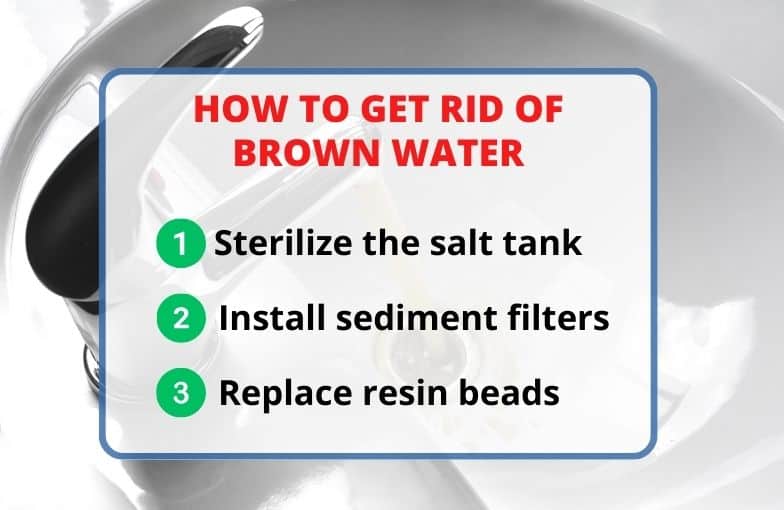
8. Troubleshooting Regeneration Issues
If the water softener fails to initiate the regeneration process, it can result in hard water issues and diminished softening efficiency. In this case, the timer initiating regeneration cycles may be damaged or malfunctioning which is preventing proper regeneration scheduling. Here are the possible causes and their fixes you should know:
Faulty Regeneration Timer
A malfunctioning regeneration timer disrupts the regeneration cycle. Consider repairing by checking specific faults like misalignments and electrical issues or replacing the timer to restore proper functioning.
Tube Blockage and Switch Issues
Sometimes, accumulated sediment or debris in tubes disrupts water flow, affecting regeneration. To address this, inspect and clear tube blockages with a brush or pipe cleaner to ensure proper water flow. Once done, confirm this by running the flush cycle.
Stuck Regeneration Cycles
If your water softener continuously cycles through regeneration without completing the process, it can lead to inefficiency and potential soft water shortages. One of the common reasons for this is insufficient water pressure, resulting in continuously initiating regeneration cycles.
To fix, verify that the water supply to the softener is operating at the recommended pressure. For instance, as a general rule of thumb, most softeners have a water pressure range from 24 to 125 pounds per square inch.
9. Investigating Unusual Noises
When investigating unusual noises in a water softener, it’s crucial to identify and address the source promptly to ensure the system’s optimal performance. One common cause of strange sounds is the presence of air in the water lines, often resulting in a gurgling or hissing noise.
Another potential source of noise is the motor during the regeneration cycle. If the sounds are unusually loud or grinding, it may indicate a problem with the motor or gears.
Solution
Here’s how to deal with unwanted noise:
- To get rid of the airlock in pipes, open the closest faucet near the softener and make sure your bypass valve is completely open.
- Inspect the water lines and essential components like valves, motors, or timers.
- If you find any loose screws, tighten them, as they result in vibrations and produce noise. Also, if you find any broken parts, replace them with new ones.
10. Fixing Leaks
Discovering a water softener leak can be concerning, but addressing it promptly is crucial to preventing further damage. It may result from loose connections or damaged fittings. Similarly, brine or resin tank leaks can occur due to cracks or damaged seals.
Solution
Here’s a step-by-step guide to fixing it.
- Examine all external connections, including inlet and outlet pipes, valves, and fittings.
- Tighten loose connections using the appropriate tools, like plumber’s tape or adjustable wrench.
- Inspect the float valve in the tank. Make sure it moves freely and does not cause an overflow.
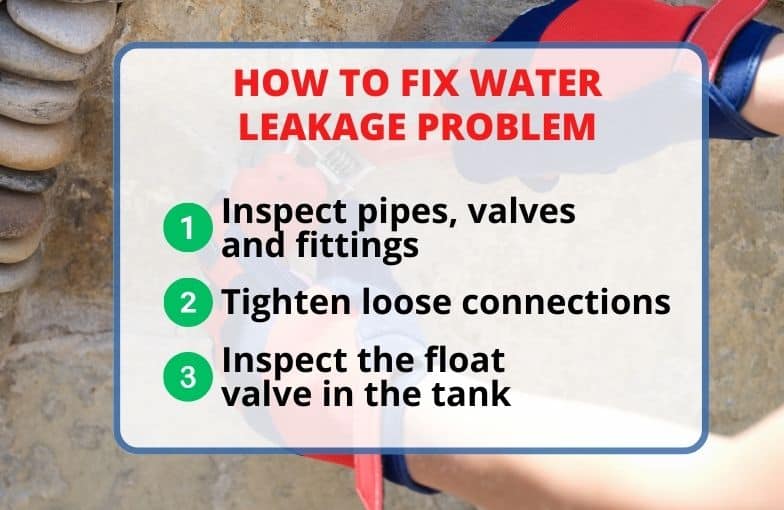
11. Correcting Improper Setup
Incorrect regeneration frequency, water hardness, or other parameters might reduce water softener efficiency. Thus, working on it immediately is ideal.
Solution
Get your water softener set up like this.
- Start by checking the electrical connections of the softener. If it has a battery backup, ensure the batteries are functional.
- Ensure the drain line, inlet, and outlet valves are open and unobstructed.
- Examine water hardness. Set it correctly by increasing or decreasing it depending on your water supply. Adjust the salt tank dosage settings to the optimal level as discussed above.
- If the issue persists, you can do the factory reset in some models. To do that, go to system/maintenance and search for “factory reset.” Then, follow the on-screen prompts to confirm the reset.
12. Addressing Water Pressure Reduction
Several things like clogged lines and mineral accumulation may cause a drop in water pressure after installing a water softener. Troubleshooting and fixing the issue is detailed below:
Ensuring the Right System Size
Addressing water pressure reduction involves understanding various factors that can impact the efficiency of a water softener installation. I once faced this issue when my family expanded, and our water softener proved insufficient. However, upgrading to a larger unit immediately resolved the problem.
Clearing Resin Clogs
Over time, the resin bed in the water softener tank accumulates sediment or becomes clogged which affects water flow and pressure. To troubleshoot, use a resin bed cleaner to remove sediment and debris. After that, initiate a system flush to eliminate any remaining impurities.
You can also try running water through the system without adding salt to help clear the resin bed, and it will work like a charm.
Dealing with Iron or Sediment Accumulation
Accumulation of iron or sediment in the softener system can also hinder water flow and reduce pressure. Consider installing a pre-filter before the water softener to capture larger particles. You can also periodically flush the water softener system to remove accumulated iron or sediment.
13. Recognizing Signs of a Died Water Softener
The term “died” implies the water softener’s complete failure. One of the most common reasons for this is the power issues that lead to the apparent failure of the complete system.

Solution
Here’s how to fix a not-responding softener:
- Examine the power cord for any visible damage.
- Confirm the functionality of the outlet by plugging in another electronic device.
- Check the control panel for error messages or signs of malfunction.
- Power off the water softener, wait a few minutes and then power it back on to see if the display resets.
- If the outlet is working fine, change the power cable of your system. If it still does not work, see professional help, as there might be an issue with the circuit board.
Manufacturer-Specific Problems
Learn about the issues that Whirlpool, Culligan, GE, and SpringWell water softeners may face, such as low water pressure, error codes, or leaking.
- Whirlpool: These water softeners may have excessive water in the brine tank, which can cause the system to malfunction. They may also have broken air valves that can cause issues with the system.
- Culligan: Water softeners may have low water pressure, which a clogged drain hose, brine tube, or brine tank can cause. They may also have valves that cause air discharge and must be checked and replaced if broken.
- GE: Reprogramming or replacing the control valve can fix error codes that GE water softeners may display. They may also have Venturi valves that require regular cleaning and inspection to prevent a loss of water pressure.
- SpringWell: It may be necessary to flush out or replace damaged parts on SpringWell water softeners to fix leaks. They may also have bypass valves that must be checked and activated properly to ensure the system functions correctly.
By identifying these specific problems and taking the necessary steps to address them, you can ensure their water softener is functioning efficiently and effectively.
How to Avoid Water Softener Issues and Extend the Life of Your System
Even though the majority of water softener maintenance is straightforward and infrequent, there are a few regular tasks you can perform to maintain the efficiency of your system:
- Clean the outside: Use warm water water and a light soap to clean the softener’s outside. Never use strong, abrasive cleaning solutions or comparable substances like vinegar or bleach.
- Don’t Stack: Just because your softener looks like a table doesn’t mean you should stack them. Refrain from stacking or positioning bulky items above the salt storage tank or the timer cover.
- Prepare in advance: To keep the salt storage tank running at its best, it must be cleaned regularly. It is helpful to plan ahead in this situation. This cleaning should be planned when the salt supply is low, usually every few years. Rest assured, your supplier ought to assist with cleaning the brine tank.
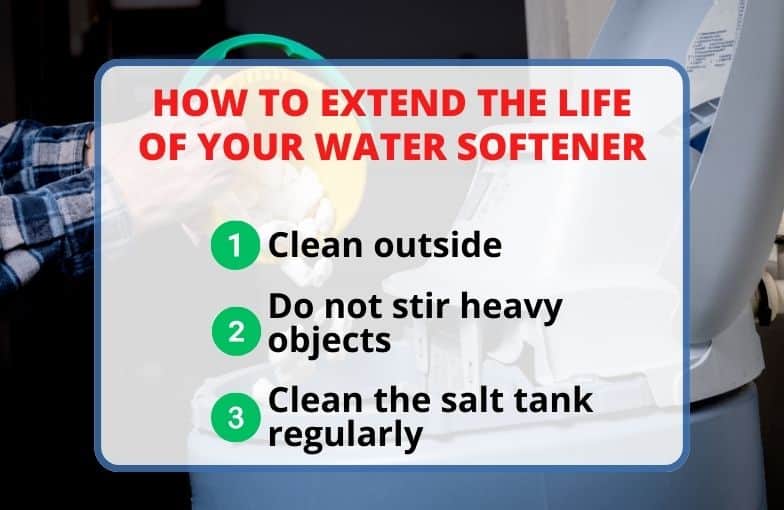
For further insights, I would recommend you check this helpful visual guide.
FAQs
How often should I clean and inspect my water softener’s Venturi valve?
To ensure proper water softener function, it’s recommended to inspect and clean the Venturi valve every 6-12 months. This Venturi water softener maintenance frequency can prevent loss of water pressure and ensure efficient operation.
Is it normal for soft water to have a slightly salty taste?
Did you know that water softeners only remove minerals that cause hard water and don’t add any salt to the water? A slightly salty taste in soft water is not normal and may indicate a malfunctioning system. Hard water can cause damage to appliances over time.
Can using high-purity salt prevent issues with the brine tank?
Using high-purity salt in your water softener can prevent issues with the brine tank, such as clogging and sediment buildup. It dissolves more efficiently, reducing the strain on the system and benefiting its performance and longevity.
How do I disinfect my water softener system?
To disinfect your water softener, use a sanitizing agent like bleach or hydrogen peroxide. Follow the manufacturer’s instructions and flush the system thoroughly afterward. Regular cleaning techniques and maintenance tips will also help keep your system free of bacteria and buildup.
What are some signs that it’s time to replace my water softener altogether?
If your water softener frequently breaks down, is over 10 years old, or requires frequent repairs, it may be time to consider replacement. Maintenance frequency can also indicate the need for a new system.
How can I test if my water softener is working?
To test the functionality of your water softener, you can use water hardness test strips. These strips are readily available and can help you determine the effectiveness of your water-softening system.
What are the signs that your water softener is going bad?
Indications of a failing water softener include visibility of hard water symptoms, such as scale buildup on faucets and fixtures, soap scum in sinks and showers, and a decline in the overall quality of softened water.
Can you reset a water softener?
Yes, you can reset a water softener. Refer to your specific model’s manual for instructions on how to initiate a reset. Typically, the process involves accessing the control panel and using the reset button.
How can you tell if your water softener is clogged?
Signs of a clogged water softener include reduced water flow, insufficient softening, or irregular regeneration cycles. Moreover, you may notice salt not dissolving properly in the brine tank.
Why is the salt not going down in my water softener?
If salt isn’t descending in your water softener, potential issues could include a salt bridge formation or a clog in the brine line. Check for these obstructions and address them accordingly to ensure proper functioning.
Why is my water softener not using salt, with no salt bridge?
If your water softener is not utilizing salt despite the absence of a salt bridge, inspect the brine tank’s components. A malfunctioning float or water entry valve could contribute to the issue. Ensure these elements are functioning correctly.
Can I unplug my water softener to reset it?
No, unplugging your water softener is not the appropriate way to reset it. The best way is to utilize the reset button which is mainly found in the control box.
Conclusion
The final say is that water softener troubleshooting is not a difficult thing to do. All you have to do is just follow some simple DIY guidelines. If there are big chunks of salt accumulated in the tank, you need to break them with the help of a rod or broom.
If you are experiencing a salty taste, you need to tweak the dosage settings and make sure they are according to manufacturer guidelines. Furthermore, to cater to leaking issues, inspect outlet valves and pipes. Tighten the loose connections and the issue should be resolved.
Regularly cleaning and inspecting components, replacing worn-out parts, and monitoring salt levels can help prevent problems before they start. By taking a proactive approach to maintaining your water softener, you can ensure that it continues to function properly and provide you with high-quality soft water for years to come.

